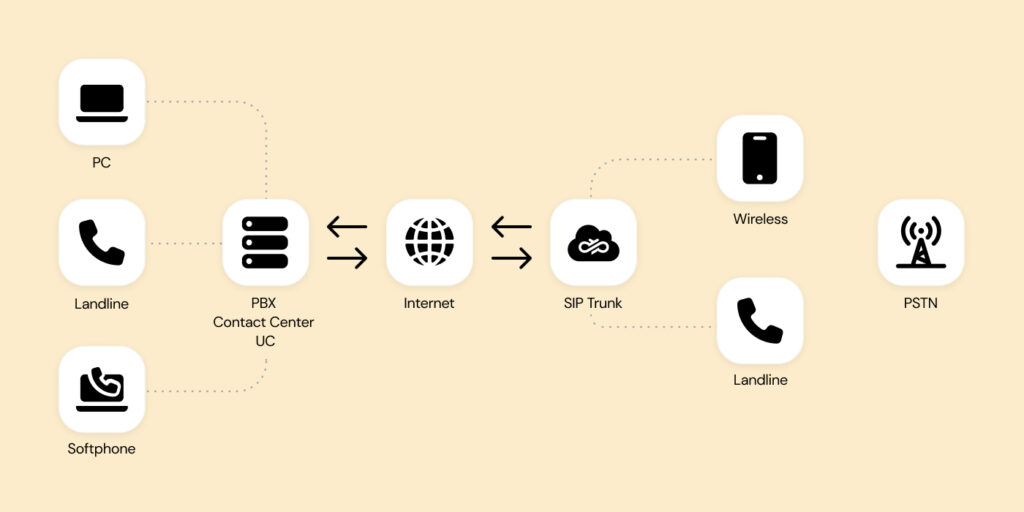Insights
How does SIP trunking work?

Insights

What is SIP trunking? How does SIP trunking work? How is it different from other technologies like VoIP and PRI? Which one makes the most sense for your company?
We’re going to dive into all of this to give you a good understanding of what it is, how SIP trunking works, and its primary benefits. We’ll also include an introduction to its close cousin: elastic SIP trunking.
SIP trunks are quickly becoming the standard for IP-based communications, replacing older technologies and enhancing enterprise communications – everything from inbound customer calls to communications with employees, vendors, and others in their network.
And while the Session Initiation Protocol (SIP) isn’t new – it’s been around for 26 years – it has more recently become the substitute for Primary Rate Interface (PRI) trunks for PBXs (private branch exchange).
Today, the SIP trunk market continues to rapidly grow. According to Transparency Market Research, it’s projected to reach $35.5 billion by 2030, growing at a 13% compound annual growth rate.
So, what makes SIP trunking a sensible choice for businesses today? And what options are available to organizations? Let’s dive in!
A SIP trunk is a VoIP technology based on the Session Initiation Protocol. Internet telephony service providers use it to deliver phone services and unified communication services with an IP-based PBX, contact center or dialer software, or an interactive voice response (IVR) setup.
Basically, a SIP trunk allows you to make phone calls – and use a full array of other multimedia communication methods – through an internet connection.
In a sense, it creates a “virtual cable” between a PBX phone system and the public telephone system (PSTN). That virtual connection also allows for video calls, messaging, SMS, and all the other methods under the unified communications (UC) umbrella. This is similar to VoIP, but there are several key differences we’ll discuss a bit later.
Over the past years, internet-based SIP trunks have been replacing analog phone lines and ISDN business phone systems.
SIP trunking services are provided by a communications service provider who uses the SIP protocol over an IP network to connect a PBX to the public switched telephone network.
The SIP protocol is used to set up, manage, and tear down a call. Multiple calls can connect over the network simultaneously, making it easy to scale up or down and be flexible for customers. Plus, the protocol works with SIP signaling – a series of communications between SIP devices sending messages back and forth using SIP response codes in a SIP session.

Here’s how this functionality would work for a simple outbound call:
Both, PRI and SIP trunks provide a connection to the PSTN. The primary difference between PRI and SIP trunks comes down to physical vs. IP-based infrastructure.
A PRI trunk uses copper wiring and a circuit-switched model to make connections while a SIP trunk provides a virtual connection to the PSTN and transmits voice calls and data through a packet-switched model.
With one PRI trunk line, you can have up to 23 voice communication channels. If you want to add more, it typically takes several weeks to deploy while SIP trunks can be scaled up or down in days or even hours. So, SIP trunking is more flexible and can reduce costs.
When it comes to call quality, PRI trunks tend to deliver higher quality since they use a dedicated voice connection. However, there are SIP trunking services that offer carrier-grade performance and built-in redundancy, ensuring high uptime and crystal-clear call quality. So, you can still remain efficient while not having to compromise on quality.
Also keep in mind that SIP trunks offer greater redundancy and better resistance to the elements, especially when using fiber-optic cables.
Most companies have moved to SIP trunks as the standard trunking service because of the greater flexibility and lower costs.
While traditional PRIs limit the number of channels companies can use unless they install additional multiples of 23, SIP trunks enable you to purchase any number of trunks based on what your business needs. This means companies no longer pay for channels they won’t use, offering a greater degree of control and flexibility over how calls are routed through a PBX system.
You might find the terms VoIP and SIP trunks both used in the context of IP-based telephony. However, it doesn’t really make sense to contrast or compare them since they’re not in direct competition with each other.
SIP is a protocol, while VoIP is a technology that transmits phone calls and text messages through the internet instead of using the PSTN. Many VoIP setups, in fact, use the SIP protocol to enable telephony over IP networks.
You can already see a number of ways SIP trunking expands the communication solutions and service capabilities for companies. Let’s run through a few of the key benefits.
SIP trunks are easily scalable over an IP connection and require no new hardware whether your communication volumes expand or contract. This is a major benefit and cost-effective solution, especially for companies with large seasonal swings of call volumes.
SIP trunks are very flexible. Customers can easily add them to new locations as needed, and they can utilize all the forms of unified communication that happen through internet technology – including international calls.
SIP trunks can provide additional useful features carried out in the service provider network, including easy troubleshooting, real-time access to call logs, and analytics.
Customers may require additional levels of security to protect privacy. If needed, SIP trunking can also leverage TLS/SRTP encryption and supports dedicated access facilities using 1 gig or 10 gig circuits to connect customer networks to the service provider.
The service provider should have an easy-to-use portal allowing customers to manage their SIP trunks, numbers, emergency services, and toll-free service.
SIP trunks are more cost-effective. Different SIP trunk pricing models are available, including pay-as-you-go and session-based pricing. PRI requires much more upfront investment, and the inflexibility of the hardware forces you to commit to certain pricing levels, even if you don’t need them.
SIP trunks are inherently reliable, and can even be more reliable than analog circuits. It’s best to increase reliability by having multiple connections to a service provider network. For example, a service provider may have network “on ramps” in multiple cities, allowing customers to have redundant access to the network.
SIP trunking supports many services including Bring Your Own Carrier (BYOC) for popular communications and contact center solutions. These cloud-based services allow a customer to use a telecommunications carrier of their choice.
Here are a few ways to leverage SIP trunks:
There are many SIP trunk providers on the market. Here are key considerations as you search for the right service.
First, private networks tend to have better quality control, faster recovery time, and superior overall service. Look for companies that have their own network. If a network failure or outage happens, can your chosen service quickly identify issues and seamlessly reroute your calls?
Continuity and quality of service matters, and a private network with built-in redundancy is the key feature to look for regarding this issue, in addition to round-the-clock monitoring, so you never lose uptime.
You want continuity, reliability, and redundancy.
Next, your chosen provider must offer coverage where your organization requires service. If they don’t, do they have a way of facilitating it for you?
To give you an idea of what is possible: Sinch’s SIP trunk network spans 95% of the U.S. with full redundancy across multiple geographic regions, ensuring maximum uptime and quality.
Because it’s internet-based, you need a SIP trunk service with proven security measures against disruptions and hacks, such as distributed denial-of-service attacks (DDOS). Ask the services you’re considering if they have experienced any attacks in the last couple of years, and how they handled it.
Do they provide network analytics on how the network is performing? Because SIP trunks are so flexible and scalable, you want to know how your communication system is performing during the various scenarios you’ll encounter, such as a holiday rush or a weather-related incident.
Sinch, for instance, delivers 24/7 monitoring and rapid failover capabilities.
Also, make sure you can easily port numbers into your chosen service. Find out if they have the skills and the resources to help a customer manage large-scale ports. And, you should be able to fairly easily manage your system using your SIP trunk provider’s portal service. Make sure they have an intuitive interface and portal system.
At Sinch, for example, when using Elastic SIP Trunking, you can simply port numbers within the Sinch Dashboard. Sinch also has an experienced porting team to help manage large migration projects when needed.
“We’ve ported numbers for 16 years now and have never come across a porting team so easy to work with – they make the impossible possible.”
For large projects, look for a service that’ll assign you a dedicated project manager. And find out if they charge for technical support. Do they offer assistance with technical, service-related issues? And if so, is there a single agent responsible for managing your account or do you speak to a different professional each time?
Either option can be fine depending on your needs, but if this matters to you, find a service that fits your preference.
Also, they should be able to share their service track record. For instance, what is their average response time for addressing new support tickets? And, find out if they use service-level agreements (SLA).
With one of the largest owned-and-operated facilities-based footprints and geo-redundant network which delivers over 300 billion minutes of use annually, Sinch has been ranked as one of the largest SIP trunking providers in North America four years in a row.
Elastic SIP trunking is even more flexible than the standard variety. With non-elastic SIP trunks, you basically have to pay for all the virtual telephone lines that can support all your concurrent active calls, in all the communication channels and methods SIP makes possible.
With elastic SIP trunks, you pay only for the minutes you spend on terminated or originated calls, and the service tracks the time spent communicating through the system, and charges you accordingly. This results in substantial cost savings and no flat-rate billing.
In addition to lower costs, there are other benefits of the elastic approach.
You’ll receive more calls because there’s no cap on how many virtual lines you have available. You have unlimited concurrent call capacity. You can quickly purchase and start using new virtual phone numbers when you need them, and then remove them when you don’t.
And, because elastic SIP trunks are entirely cloud-based, managing them is more convenient for your IT team, even when they need to change calling capacity in real time.
Interested in more detailed setup instructions? Follow our documentation to see how to set up Elastic SIP Trunking with Sinch.
Sinch offers reliable and scalable Elastic SIP Trunking services.
Again, this means you can scale up or down as your company requires and get global coverage with a single provider. With pay-as-you-go pricing, you only pay for minutes you use, which optimizes your costs, improves efficiency, and prevents over-provisioning.
Our Elastic SIP Trunks feature carrier-class performance and redundancy, so you don’t have to worry about call quality.
And, Sinch’s platform features top-tier security and reliability. You can easily encrypt your calls and signaling using industry-standard SRTP/TLS protocols, which ensures that every communication is secure from end to end.